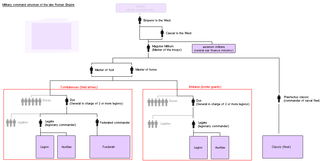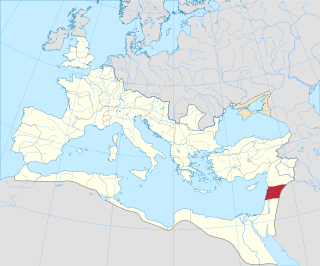
Magister militum was a top-level military command used in the later Roman Empire, dating from the reign of Constantine the Great. The term referred to the senior military officer of the empire. In Greek sources, the term is translated either as strategos or as stratelates.
Prosopography is an investigation of the common characteristics of a group of people, whose individual biographies may be largely untraceable. Research subjects are analysed by means of a collective study of their lives, in multiple career-line analysis. The discipline is considered to be one of the auxiliary sciences of history.
The logothetes tou stratiotikou, rendered in English as the Logothete of the Military or Military Logothete, was a Byzantine imperial official in charge of the pay and provisioning of the Byzantine army. The office appears in the late 7th century and is mentioned until the 14th century.
David Saharuni was sparapet, curopalates, ishkhan, and presiding prince of Byzantine-controlled Armenia from 635 to 638.
John Robert Morris was an English historian who specialised in the study of the institutions of the Roman Empire and the history of Sub-Roman Britain. He is best known for his book The Age of Arthur (1973), which attempted to reconstruct the history of Britain and Ireland during the so-called "Dark Ages" following the Roman withdrawal, based on scattered archaeological and historical records. Much of his other work focused on Britain during this time.

The praefectus annonae, also called the praefectus rei frumentariae was a Roman official charged with the supervision of the grain supply to the city of Rome. Under the Republic, the job was usually done by an aedile. However, in emergencies, or in times of extraordinary scarcity, someone would be elected to the office, and would take charge of supplying the entire city with provisions.
The Prosopography of the Byzantine World (PBW) is a project to create a prosopographical database of individuals named in textual sources in the Byzantine Empire and surrounding areas in the period from 642 to 1265. The project is a collaboration between the British Academy and the Berlin-Brandenburg Academy of Sciences and Humanities.
Afranius Syagrius was a Roman politician and administrator.
Rodelinda (6th-century), was a Lombard queen by marriage to king Audoin, and mother of king Alboin.
Helena was a niece of Byzantine Empress Sophia. She is known only because of Georgios Kedrenos and the Suda. They mention a statue of her in the Milion, alongside statues of Sophia and Arabia, respectively the wife and daughter of Justin II.
Vigilantia was a sister of Byzantine emperor Justinian I, and mother to his successor Justin II.
Boraides was a cousin of the Byzantine emperor Justinian I, better known for his role in ending the Nika riots of 532. The primary source about him is Procopius.
Masuna or Massonas was a Berber from what is now western Algeria who was said to have been a Christian, he ruled the Mauro-Roman Kingdom with its capital based in Altava which is now in present-day Algeria around the Tlemcen area. He was able to maintain the independence of his kingdom by resisting occupation from the Vandals. King Masuna allied with the Eastern Roman Emperor Justinian and assisted him in a war against the Vandals in 533 and also against other invading Berber tribal confederations. During his reign he was obeyed by the tribes of Mauretania.
Seleucus also known as Flavius Seleucus and Count Seleucus was a wealthy Greek rhetor who was a close friend of Libanius and the Roman emperor Julian.

Phoenice was a province of the Roman Empire, encompassing the historical region of Phoenicia. It was officially created in 194 AD and after c. 394, Phoenice Syria was divided into Phoenice proper or Phoenice Paralia, and Phoenice Libanensis, a division that persisted until the region was conquered by the Muslim Arabs in the 630s.
The Prosopographia Imperii Romani, abbreviated PIR, is a collective historical work to establish the prosopography of high-profile people from the Roman empire. The time period covered extends from the Battle of Actium in 31 BC to the reign of Diocletian. The final volume of the second edition, PIR2, vol. IX, V–Z, appeared in November 2015.
John Robert Martindale is a British historian specializing in the later Roman and Byzantine empires. Martindale's major publications are his magnum opus, the Prosopography of the Later Roman Empire, begun by A. H. M. Jones and published between 1971 and 1992, and the first part of Prosopography of the Byzantine Empire, which was published in 2001.
Lucillianus was a Roman military commander during the emperor Julian's disastrous expedition against Sasanian Empire in 363.

This article lists historical events that occurred between 301–400 in modern-day Lebanon or regarding its people.



